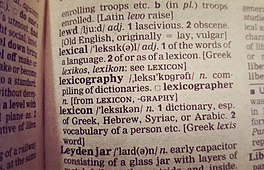Documentation:RelLex/California Indian Linguistic Records: The Mission Indian Vocabularies of Alphonse Pinart
California Indian Linguistic Records: The Mission Indian Vocabularies of Alphonse Pinart
| Relational Lexicography Knowledgebase | |
|---|---|

| |
| About RelLex | |
| An index of under-resourced North American language references, including print and digital dictionaries. | |
| Browse by | |
| About the Knowledgebase | |
| Find our filterable Knowledgebase of dictionaries and lexicography technology at https://knowledgebase.arts.ubc.ca/. | |
Language Name
Cruzeño, Esselen, Northern Costanoan, Purisimeño, Salinan, Samala, Southern Costanoan, šmuwič, Ventureño
Alternate Language Names
Cruzeño - Island Chumash, Isleño, Limue, Huyma, Siuxton; Esselen - Huelel; Northern Costanoan - Northern Ohlone; Purisimeño - Central Chumash, La Purisima Language; Salinan - Tokakui, Tesxaya; Samala - Ineseño, Central Chumash, Alaxulapu; Southern Costanoan - Southern Ohlone, Mutsun; šmuwič - Barbareño, Central Chumash, Mupu; Ventureño - Central Chumash, Mitskanaxan.
Region
California (Central), United States.
Who
Alphonse Pinart (Historical Document Author); R. F. Heizer, (Editor of this volume).
Others Involved
Mr. Robert J. Squier (Research Assistant); Dr. Donald C. Cutter (Editor of Spanish Translations).
Consultants for each source are cited in the Introduction: Coleta (of the Mission of Nuestra Señora de la Soledad) – Costanoan I; Eulogia (of Mission Santa Cruz) – Costanoan II; Rustico (at Aptos) – Costanoa III; Ventura/Buenaventura (of Carmel) – Costanoan IV; Luis (of Mission Santa Ynes, living in San Buenaventura) – Chumash I; The wife of Luis (at San Buenaventura) – Chumash II; wife of Roberto Salazar (of Santa Paula, recorded at San Buenavenutura) – Chumash III; Cecilio (recorded at Rancho Saka, now of Santa Ynez) – Chumash IV; Martina (of the Island of Santa Cruz, now living in San Buenaventura) – Chumash V and VII; Balthazar (of the Island of Santa Cruz, now living in San Buenaventura) – Chumash V and VI; Omesia (born in Guacaron) – Esellen I; no speaker cited – Salinan I.
Publishing Information
Published 1952, University of California Press, Berkeley and Los Angeles. Anthropological Records Vol. 15, No. 1.
This resource was published as the first in a series with the aim to make previously inaccessible records available. It is an edited version of Alphonse Pinart's earlier work. The vocabularies are reproduced as they are in the original manuscript.
How People are Cited
Speakers for each language and contributors for the entire volume are cited in the Introduction.
How Information is Cited
Information is cited in the Introduction and in the Bibliography. The original manuscripts and the consultant speakers are cited in the Introduction. Other sources are cited in footnotes and in the Bibliography.
Where is Information Coming from
The information in this resource comes from Alphonse Pinart's previously unpublished vocabularies. Additional sources are cited in the Bibliography.
Tools and Framework used
This dictionary is available as a physical book and digital book (PDF).
Access
The physical book is accesible through libraries. The digital book is open access through UC Berkeley Library's online collections.
Included Languages and Directionality
The resource includes Salinan, Chumash, Costanoan, and Spanish. Some French is included occasionally, as the author of the unpublished vocabularies, Alphonse Pinart, was French.
The includes languages and directionality for each section is as follows. There are multiple columns for Costanoan and Chumash in Part 1 and 2 respectively, which represent individual speakers:
Part 1 (Costanoan): English - Spanish - Costanoan I - Costanoan II - Costanoan III - Costanoan IV
Part 2 (Chumash): English - Spanish - Chumash I - Chumash II - Chumash III - Chumash IV - Chumash V - Chumash VI - Chumash VII
Part 3 (Salinan - Esselen): English - Spanish - Salinan - Esselen
Dialects Included
The proposed dialect of each consultant is included in the Introduction. This resource includes multiple dialects and dialect variants.
Type of Dictionary
This is a multilingual comparative wordlist.
How are Entries Organised
There is no organized ordering for the entires. The entries in each language column come from a single speaker.
Other Features
| Feature | Included | More Information |
|---|---|---|
| Guide to use and understand | ❌ | |
| Audio | ❌ | |
| Images | ❌ | |
| Example phrases | ❌ | |
| Speakers marked | ✅ | Each column of entries belongs to a single speaker, who are named in the Introduction |
| Dialects marked | ❌ |
External Links
Reference on WorldCat: https://www.worldcat.org/title/3392892
View or download the open access PDF: https://digitalassets.lib.berkeley.edu/anthpubs/ucb/text/ucar015-001.pdf